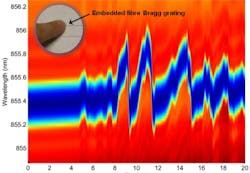Stretchable polymer skin wired with Bragg gratings senses strain
Leuven, Belgium--Imec and its collaborators have demoed a stretchable polymer optical-sensing skin, which can measure mechanical strain and pressure. The device is a result of a project, Photonic Skins For Optical Sensing (PHOSFOS), supported by the European Commission under the 7th framework (FP7) and begun in 2008.
The polymer pad contains integrated optical Bragg sensors, as well as the optical sources and detectors needed to read out the sensors. These pads could, for example, continuously monitor the integrity and the behavior of buildings, dams, bridges, roads, or tunnels. Other uses are monitoring aircraft wings, helicopter blades, or wind-turbine blades. They could be used in the biomedical arena as well, for long-term monitoring of respiration and cardiac activity and the detection of pressure points under bedridden patients.
The sensing elements consist of fiber Bragg gratings fabricated in microstructured optical fibers. The researchers were able to make pressure sensors that are 20 times more sensitive than comparable state-of-the-art sensors. In addition, the sensors are temperature insensitive. The researchers exploited the unique advantages of polymer fibers over glass fibers—their ability to measure much higher strains, their safer use in medical applications, and their ability to be read out with lower-cost interrogation systems.
The first pre-product prototype measures downhole pressure during oil or gas exploration. The second is a medical sensor to measure esophageal pressure and to diagnose gastrointestinal disorders. The third is a portable system capable of monitoring respiratory activity.
For more info, see: http://www.phosfos.eu/

John Wallace | Senior Technical Editor (1998-2022)
John Wallace was with Laser Focus World for nearly 25 years, retiring in late June 2022. He obtained a bachelor's degree in mechanical engineering and physics at Rutgers University and a master's in optical engineering at the University of Rochester. Before becoming an editor, John worked as an engineer at RCA, Exxon, Eastman Kodak, and GCA Corporation.
